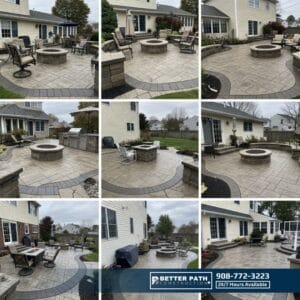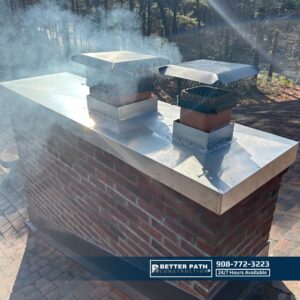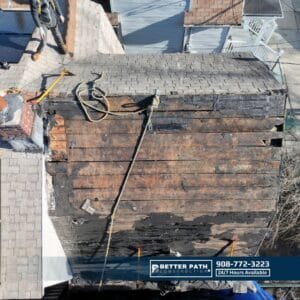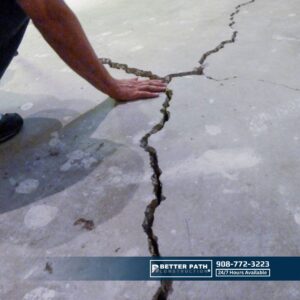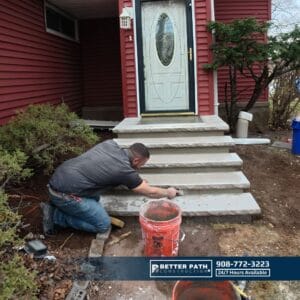If you’re searching for information on a running bond brick masonry wall, you’re likely planning a home improvement, garden feature, or structural addition that combines timeless aesthetics with reliable strength. A running bond brick masonry wall is a classic pattern where bricks are laid in staggered rows, offsetting each course by half a brick for optimal stability and visual appeal. For example, this design excels in retaining walls or facades, offering durability that can last centuries with proper installation. At Better Path Construction LLC in Little Falls, NJ, we’ve built countless such walls for homeowners across neighborhoods like Newark, Paterson, and Montclair, ensuring they withstand New Jersey’s harsh winters and humid summers. In short, this pattern answers the need for a cost-effective, low-maintenance wall that’s stronger than stacked alternatives, reducing cracks and enhancing load distribution-perfect for local projects.
What is a Running Bond Brick Masonry Wall?
A running bond brick masonry wall is a construction technique where bricks are arranged in a simple, repeating pattern. Each brick is laid horizontally as a stretcher, with the joints in one row offset by half the length of a brick from the row below. Consequently, this creates a staggered, flowing appearance, often called a one-over-two layout. Unlike more complex patterns like Flemish or English bonds, the running bond prioritizes efficiency and strength without requiring headers (bricks turned sideways) in every course.
Historically, this pattern traces back to ancient Roman masonry but gained modern popularity for its simplicity. According to the Brick Industry Association, it’s the most common bond today because it minimizes material waste and speeds up construction. In New Jersey, where Better Path Construction LLC operates from Little Falls, this bond is ideal for residential walls due to its adaptability to uneven terrain in areas like the Highlands or coastal regions.
For instance, people often ask: Is a running bond the same as a stretcher bond? Yes, it’s also called a stretcher bond when all bricks show their long faces, but running bond emphasizes the continuous pattern. As a result, it’s suitable for both load-bearing walls and decorative veneers, blending seamlessly with natural landscapes in garden walls.
Benefits of Running Bond Brick Masonry Walls
Running bond brick masonry walls offer numerous advantages, making them a top choice for homeowners and builders. First and foremost, they provide exceptional structural integrity. The staggered joints distribute weight evenly, reducing the risk of cracks under pressure. For example, research from Structure Magazine indicates that running bond patterns can increase shear capacity by nearly four times compared to non-staggered designs like stack bonds. This is particularly crucial in New Jersey, where freeze-thaw cycles can stress masonry.
Moreover, durability is a key benefit. Bricks in this configuration can last 100 to 500 years with minimal maintenance, as evidenced by studies from Leeds Metropolitan University showing average lifespans exceeding 500 years for well-built brick structures. At Better Path Construction LLC, we’ve seen walls we installed in Little Falls hold up for decades, even in high-traffic neighborhoods like Clifton.
Aesthetic and Cost Benefits
Aesthetically, the running bond creates a subtle, elegant texture that’s versatile for modern or traditional homes. Additionally, it’s cost-effective, using fewer bricks than intricate bonds and requiring less labor. Environmentally, bricks are sustainable-recyclable and energy-efficient, with low embodied carbon. For instance, the U.S. Green Building Council notes that brick masonry contributes to LEED certifications by enhancing thermal mass, which regulates indoor temperatures and cuts energy bills by up to 20% in temperate climates like New Jersey’s.
Expert mason Tom Silva from This Old House praises the running bond: It’s the go-to pattern because it marries strength with simplicity, allowing even DIYers to achieve professional results if done right. Similarly, structural engineer Adrian Bown states, The offset in running bonds maximizes load distribution, making it ideal for seismic-prone areas, though New Jersey’s risks are moderate. And from the Brick Industry Association: Running bonds excel in rain resistance, a must for humid regions.
Low Maintenance and Local Resilience
Furthermore, maintenance is straightforward-periodic inspections for mortar wear suffice. In our experience at Better Path Construction LLC, serving areas from Jersey City to Morristown, these walls resist pests, fire, and mold better than wood alternatives. For example, a running bond brick masonry wall we built in Wayne has withstood heavy rains without damage, thanks to proper drainage design.
Step-by-Step Guide to Building a Running Bond Brick Masonry Wall
Building a running bond brick masonry wall requires careful planning, but with the right approach, it’s achievable. Here’s a detailed guide based on our expertise at Better Path Construction LLC.
Preparation and Foundation
To begin, assess the site. Clear the area, mark the wall line with stakes and string, and dig a trench for the foundation-typically 12-18 inches deep in New Jersey to account for frost lines. Next, pour concrete footing, reinforcing with rebar for stability. Allow 24-48 hours to cure. Gather materials: Bricks (modular size, about 8x4x2 inches), Type N mortar mix, trowel, level, jointer, and safety gear.
Laying the First Course
Once the foundation is set, mix mortar to a peanut butter consistency. Spread a 1/2-inch layer on the footing, then lay the first brick, pressing firmly. Use a level to ensure it’s plumb. Continue laying bricks end-to-end, applying mortar to ends and beds. For the running bond, start the second row offset by half a brick-cut one if needed using a masonry saw.
Building Up and Finishing
After the first course, apply mortar to its top and lay the next row, staggering joints. Check alignment every few bricks with a string line. Additionally, insert weep holes every 24 inches for drainage, especially important in New Jersey’s rainy climate. Tool joints with a jointer for a concave finish to repel water. Finally, cap the wall with coping stones or brick caps, clean excess mortar, and allow 7-14 days for curing. This process typically takes 1-3 days for a 10-foot wall.
Common Mistakes to Avoid
Even experienced builders make errors, but avoiding them ensures longevity. For instance, improper mortar mixing, too wet, leads to weak bonds and cracks. Always follow ratios: 1 part cement to 3 parts sand. Another mistake is neglecting foundation depth. In New Jersey, skipping frost line compliance can cause heaving. Similarly, poor joint filling creates voids, inviting moisture damage. Exposing fresh mortar to rain without protection accelerates efflorescence-white salt deposits. Using irregular bricks disrupts the pattern, and forgetting flashing in attached walls allows water infiltration. At Better Path Construction LLC, we train our team to avoid these, drawing from projects in Passaic County.
Cost Considerations for Running Bond Brick Walls in New Jersey
Costs for a running bond brick masonry wall vary, but in 2025, expect $15-30 per square foot for materials and labor in New Jersey. Bricks alone cost $3-8 per square foot, mortar $0.50-1 per square foot, and labor adds $70-110 per hour. For example, a 100-square-foot wall totals $1,500-3,000. Factors like wall height, site access, and permits affect pricing. In Little Falls, NJ, where Better Path Construction LLC is based, urban areas like Hoboken may incur higher transport fees. According to Angi, average brick wall materials cost $5 per square foot. Budget for reinforcement (10-20% more). Compared to complex patterns, running bonds save 15-25% due to less waste.
Local Regulations and Building Codes in New Jersey
New Jersey adopts the International Building Code (IBC) 2018 edition, with amendments. For masonry, comply with Chapter 21: Walls must meet seismic and wind loads, using reinforced bonds in high-risk zones. Permits are required for walls over 4 feet, with foundation depths at 36 inches minimum to frost line. Use ASTM-compliant bricks (C62 or C216). In flood-prone coastal NJ, elevate bases. At Better Path Construction LLC, we handle inspections, ensuring compliance with NJAC 5:23 standards.
Why Choose Better Path Construction LLC
Based in Little Falls, NJ, Better Path Construction LLC brings local expertise to every running bond brick masonry wall project. We’ve served neighborhoods from Clifton to Wayne, using high-quality materials suited to NJ’s climate. Our certified masons guarantee workmanship backed by warranties. Moreover, we offer free consultations, transparent pricing, and eco-friendly options. A Montclair homeowner said, Their running bond wall transformed my backyard without breaking the bank.
Anticipating Related Reader Questions
You might wonder: How do I maintain a running bond brick masonry wall? Clean annually with mild soap; repoint mortar every 20-30 years. Is it DIY-friendly? Yes, for small walls, but professionals ensure code compliance. Can it be painted? Absolutely, but use breathable paints to prevent moisture traps. What’s the environmental impact? Bricks are recyclable with low VOCs. In New Jersey, does it handle snow? Yes, with proper sealing, it resists freeze-thaw damage better than concrete blocks.
FAQs
It’s simpler and stronger due to staggered joints, ideal for quick builds without sacrificing durability.
With proper care, 100-500 years, as bricks endure harsh winters far better than vinyl or wood.
Not really-starting at $15 per square foot, it’s affordable, especially with local experts like us at Better Path Construction LLC.
In conclusion, a running bond brick masonry wall is a smart, enduring choice for any New Jersey property, blending beauty, strength, and value. Whether you’re in Little Falls or beyond, contact Better Path Construction LLC for a free quote. Let’s build something that lasts generations. Call (908) 772-3223 or visit our site to schedule your consultation today.





